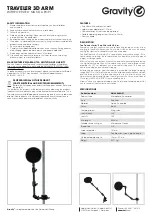
Front Panel Operation
2-128
Electrostatic interference is first recognizable when hand or
body movements near the experiment cause fluctuations in
the reading. Pick-up from AC fields can also be detected by
observing the electrometer preamp output on an oscillo-
scope. Line frequency signals on the output are an indication
that electrostatic interference is present. Means of minimiz-
ing electrostatic interference include:
1. Shielding. Possibilities include: a shielded room, a
shielded booth, shielding the sensitive circuit, and using
shielded cable. The shield should always be connected
to a solid connector that is connected to signal low. If
circuit low is floated above ground, observe safety pre-
cautions, and avoid touching the shield. Meshed screen
or loosely braided cable could be inadequate for high
impedances, or in string fields. Note, however, that
shielding can increase capacitance in the measuring cir-
cuit, possibly slowing down response time.
2. Reduction of electrostatic fields. Moving power lines or
other sources away from the experiment reduces the
amount of electrostatic interference seen in the measure-
ment.
2.21.8 Magnetic fields
A magnetic field passing through a loop in a test circuit will
generate a magnetic EMF (voltage) that is proportional to the
strength of the field, the loop area, and the rate at which these
factors are changing. Magnetic fields can be minimized by
following these guidelines:
• Locate the test circuit as far away as possible from such
magnetic field sources as motors, transformers and
magnets.
• Avoid moving any part of the test circuit within the
magnetic field.
• Minimize the loop area by keeping leads as short as
possible and twisting them together.
2.21.9 Electromagnetic interference (EMI)
The electromagnetic interference characteristics of the Mod-
el 6517A Electrometer/High Resistance Meter comply with
the electromagnetic compatibility (EMC) requirements of
the European Union as denoted by the CE mark. However, it
is still possible for sensitive measurements to be affected by
external sources. In these instances, special precautions may
be required in the measurement setup.
Sources of EMI include:
• Radio and TV broadcast transmitters.
• Communications transmitters, including cellular
phones and handheld radios.
• Devices incorporating microprocessors and high-speed
digital circuits.
• Impulses sources as in the case of arcing in high-voltage
environments.
The effect on instrument performance can be considerable if
enough of the unwanted signal is present. The effects of EMI
can be seen as an unusually large offset, or, in the case of im-
pulse sources, erratic variations in the displayed reading.
The instrument and experiment should be kept as far away as
possible from any EMI sources. Additional shielding of the
instrument, experiment and test leads will often reduce EMI
to an acceptable level. In extreme cases, a specially con-
structed screen room may be required to sufficiently attenu-
ate the troublesome signal.
External filtering of the input signal path may be required. In
some cases, a simple one-pole filter may be sufficient. In
more difficult situations, multiple notch or band-stop filters,
tuned to the offending frequency range, may be required.
Connecting multiple capacitors of widely different values in
parallel will maintain a low impedance across a wide fre-
quency range. Keep in mind, however, that such filtering
may have detrimental effects (such as increased response
time) on the measurement.
2.22 Relative humidity and external temper-
ature readings
With the appropriate options connected, the Model 6517A
can measure relative humidity and external temperature. Hu-
midity and external temperature readings are provided as a
multiple (NEXT) display for each function (see paragraph
2.3.4). These readings can also be included as data elements
for the bus interfaces (GPIB and RS-232), and for the buffer.
See paragraphs 2.16 (Buffer) and 2.19.2 (Communication)
for details.
Relative humidity
The Keithley Model 6517-RH option is used to measure rel-
ative humidity. This sensor plugs into the connector label
“HUMIDITY” on the rear panel of the Model 6517A. Note
that an extension cable (part number CA-129-1) is supplied
for the humidity sensor.
Humidity measurements are controlled (enabled or disabled)
from the A/D-CONTROLS (DATA-STAMP) item of the
GENERAL MENU (see paragraph 2.19.7).
Содержание 6517A
Страница 1: ...Model 6517A Electrometer User s Manual A G R E A T E R M E A S U R E O F C O N F I D E N C E...
Страница 310: ...A Specifications...
Страница 311: ...A Specifications...
















































